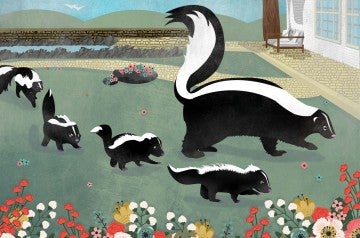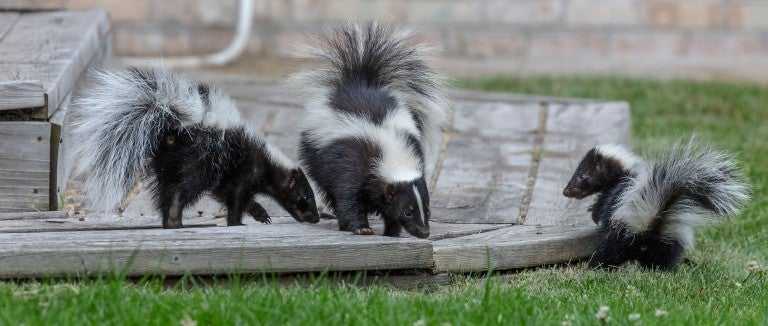It was a rude awakening: Just as my thoughts drifted into a pre-sleep jumble, a skunk pounced onto my nighttime reading. Not just any skunk, but a giant one flashing her black-and-white tail in a series of pungent leaps. Back and forth she went, bed to floor to bed, before my eyes caught up with my nose and saw the stinky beastie for who she really was: a wiry mutt reveling in new perfume.
A herding breed mix who would leap three feet upon our arrival home and nip at our ankles as we departed, Mattie was happiest when rolling in deer poop, especially after baths. So it was hardly a surprise that a shower of eau de skunk had inspired her to charge past my husband, who’d tried to contain her, and upstairs to share the news. “Yay! I got sprayed!” she seemed to say. “Let’s go outside and do it again!”
My interpretation wasn’t far off the mark. “Dogs are kind of nuts sometimes,” says Jerry Dragoo, a research assistant professor at the University of New Mexico and the man behind a myth-busting website called The Institute for the Betterment of Skunks and Skunk Reputations. “Some dogs—they get sprayed, and they will never get sprayed again. Others get sprayed and they just relish it, and they will seek out every skunk that they find just to get sprayed again.”
While wild animals understand the language of threatened skunks—raised tail, lowered front end, feet stamping—dogs can be more obtuse. “They have zero idea of how to react to the warning signs,” says HSUS urban wildlife solutions director John Griffin.
“Some dogs—they get sprayed, and they will never get sprayed again. Others get sprayed and they just relish it, and they will seek out every skunk that they find just to get sprayed again.”
Jerry Dragoo
Lost in Translation
Skunks, in turn, are terrified by excitable creatures like Mattie, who had started the mischief by sniffing under my potting bench. Skunks are so nearsighted that “they tend to see the world in terms of moving blobs,” says HSUS wildlife ecologist Laura Simon, whose affection for the animals began at age 11, when she rescued one from a sewer. Slow-moving blobs are fine, she says, but fast-moving ones that won’t stop? They’ll get what’s coming to them.
The interspecies miscommunication doesn’t end there. Humans exacerbate matters by letting dogs roam during wildlife foraging hours and by perceiving skunks as “walking time bombs,” says Griffin. “People don’t understand the myopia. A skunk might be waddling right next to them, and they think, ‘The skunk’s coming after me.’ But a skunk just sees a blurry object; it doesn’t know what’s going on.” Even the normally sympathetic Charles Darwin called skunks “odious animals,” indignantly describing the scent emitted when dogs attack.
All these misread cues add up to more than smelly spritzes; for skunks, they’re often a death sentence. Among the most commonly trapped animals, skunks are targeted by homeowners who believe they’re after gardens and pets or, inexplicably, born with rabies.
Many nuisance wildlife and pest control companies are happy to oblige unfounded fears, perhaps aiming to wipe out competition. “Skunks are a great form of natural pest control,” says Simon, dubbed “skunk adviser to the stars” after counseling Ellen DeGeneres about their grub-digging in her lawn. “And they also will eat mice and baby rats, and just their presence deters a lot of rodents.”
Skunks would rather dine on insects eating plants than on the plants themselves, says Dragoo: “If a skunk has a choice between a tomato and a tomato worm, it’ll go after the tomato worm.” Their taste for grasshoppers and beetle larvae earned praise in a 1914 U.S. Department of Agriculture bulletin, and their culinary preferences even inspired New York hops growers to lobby for their protection. But they still faced a tough crowd: “Scientific observers since the days of Audubon have nearly all testified to the usefulness of these animals,” the USDA noted, “but popular prejudices are hard to overcome.”
A century later, insecticides further obscure skunks’ ecological role. Chemical manufacturers admonish consumers that grubs invite skunks and birds to lawns, as if nature’s balancing acts were negative phenomena to be vanquished.
A humane backyard is a natural habitat offering wildlife plenty of food, water and cover, plus a safe place to live free from pesticides, chemicals, free-roaming pets, inhumane practices and other threats. And it's so easy to build!

Not an Automatic Weapon
For their part, skunks would be just as happy not to make our acquaintance. Content to keep their noses to the ground, these gentle animals aren’t looking for a fight and “don’t just spray willy-nilly,” says Simon. “They do little charges at you, and they try their very best to get a potential predator to go away.” During decades of rehabilitating orphaned and injured skunks, Simon watched babies as small as 3 inches practice feet-stamping maneuvers, eyeballing their targets while curling into a U shape to display their “business ends,” she says. “They’ll charge each other, and then they’ll slam on the brakes and topple over because they’re not that coordinated.”
At the first sign of trouble—perhaps a loud noise from behind—skunks would prefer to run if there’s an escape route, says Dragoo, also a longtime rehabilitator. Initial reactions are hard-wired, but skunks make mental calculations about what comes next. If Dragoo accidentally drops a pan in front of a skunk, her defensive instincts kick in, but she stands down upon finding no threats: “If they don’t fear for their life, they’re not going to spray.”
Without dogs, most of us wouldn’t even be aware of these unassuming animals. “A lot of people say, ‘I’ve got a skunk in my backyard: What do I do?’ And my advice is to get a lawn chair, pour a beer, put up your feet up and watch it because it’s very entertaining,” says Dragoo.
If you or your dog do get sprayed, use this neutralizer: a quart of 3-% hydrogen peroxide, 1/4 cup of baking soda and 1 teaspoon of liquid dishwashing soap. It works even on canine rascals, as I can attest.
Safety zone
You can protect skunks by driving slowly and eliminating backyard hazards.

Remove bait
When a couple brought a panicked skunk stuck in a jar to the HSUS Fund for Animals Cape Wildlife Center in Massachusetts last year, staff anesthetized him, removed the jar, treated his abrasion and released him. He was lucky, says executive director Deborah Millman, unlike those never found. “It’s sad when you think about what they must go through.” Small yogurt containers are the biggest offenders, says Simon, because of the openings’ angled rims. Cut up the cups, secure trashcans and remove garbage and pet kibble to prevent mishaps.
Close death traps
Add covers to window wells. Rescue already fallen skunks by lowering a prostrate kitchen garbage can with cheese into the well. Skunks find cheese so delectable that “a bomb can go off and that skunk is not going to react,” says Simon. Once the skunk walks in, gently lift the can, place it on the ground, and wait for the skunk to leave. Don’t worry about spraying; skunks don’t spray what they can’t see.
Rescind invitations
Use welded wire to seal holes in concrete slabs or other openings. But check first for tenants by plugging entryways with soil or leaves; skunks, if present, will dismantle it overnight. Wait until families leave, or contact a humane service that places babies in a reunion box outside the structure, installs a one-way door and waits for the mother to exit and carry her dependent young to an alternate den site. Ditch grass. Turf-digging is seasonally restricted to when soil is wet, says Simon. Sprinkle cayenne pepper as a deterrent, or—better yet—replace grass with wildlife-friendly plants.
Leash pets
Recently, the HSUS’s Fund for Animals Wildlife Center in California took in five skunk babies after a dog killed their mother. Prevent unnecessary orphaning by monitoring pets, especially at dawn and dusk.
Want more content like this?
This was written and produced by the team behind All Animals, our award-winning magazine. Each issue is packed with inspiring stories about how we are changing the world for animals together.
Learn MoreSubscribe
